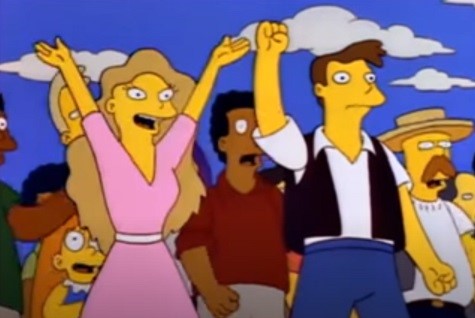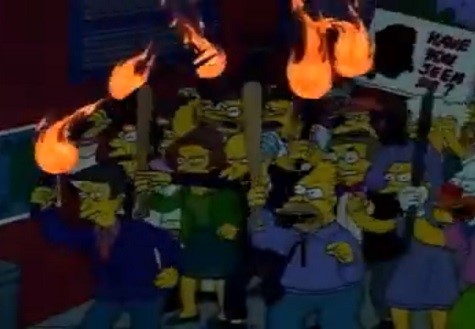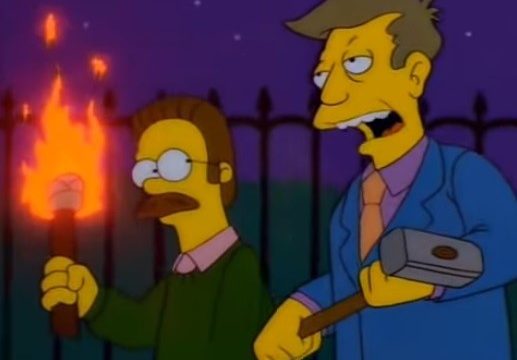“Can’t this town go one day without a riot?” — Mayor Quimby
Miller here:
The Simpsons thinks everything is stupid. It is not wrong! Like MAD magazine, its only cohort in scope, it craps on all aspects of life – family, religion, education, government, entertainment, friendship, love – and makes no exception to its mockery. But the show hits certain areas harder than others.
While other disgruntled groups appear earlier on, the show’s eighth episode, “The Tell-Tale Head,” is where we first see one of the show’s most consistent and enduring depictions: The Angry Mob. Outraged citizens chase Bart after he cuts the head off the town’s statue of Jedediah Springfield, an early instance of property being valued more than life. Bart eventually talks them down, but the mob has remained restless since: demanding placebos and monorails, denouncing immigrants and bordellos, delivering misguided justice to bootleggers and cat burglars. After an ursine invasion of one, and before their attention is diverted to attacking immigrants, the mob marches on City Hall, their battle cry as loud as it is idiotic: “We’re here! We’re queer! We don’t want any more bears!”
America is a populist country, one that must always at least pay lip service if nothing else to the concerns of a group even if that group can be manipulated by others only slightly cleverer. As far as I can tell, ground zero for the Simpsonic mob comes midway through The Adventures of Huckleberry Finn, where a rich man shoots a drunk down in the street like a dog because the drunk is being a jerk. The town comes out to lynch the rich man – he committed murder, after all – only to slink away in shame when he insults their overall shoddiness and lack of spine. A century and a half later, the citizens of Springfield boo Mayor Quimby when he supports the disgusting holiday of Whacking Day, in which snakes are beaten to death, and he fires back in turn. “You’re nothing but a pack of fickle mush-heads!” the Kennedy-esque executive yells, and the populace falls in line with a new show of force. “He’s right! Give us hell, Quimby!”

The Simpsons was written by nerds, for nerds. Harvard eggheads and Hollywood weirdos had control of a network TV show for an unprecedented amount of time, using the astonishingly stupid outrage over a rude cartoon eight-year-old as cover for much greater subversion of everything Americans held dear. And because they were nerds and weirdos, people who had always been on the outside of the group and its stupidest vagaries, they took their revenge on popularity and populism, consistently showing groups at their worst. And their most fervent audience, the nerds a generation younger than them, at least my friends and me for whom the show was both a bible and a vernacular, took their words to heart. The more people come together, the stupider they will be.
Looking out at the world, is this wrong? People will unite behind the stupidest shit imaginable. Now think of this in the context of adolescence, where almost everything seems stupid beyond belief. It’s a relief to see something acknowledge this, even if it can’t be changed. At least you can laugh at the fools.
The Simpsons ofthe 90s, before it turned to an echo of an echo, shaped my thoughts more than anything else (with the possible exception of the aforementioned MAD magazine), and while my view of the world has expanded since then, I have not found much wrong in what I’ve learned from a half-hour cartoon about how the world works. Whatever that says about me, it also says about the world. But what challenges am I not considering because of that understanding? What parameters am I ruefully nodding at?

The Simpsons has taken on Frank Capra at several points, making fun of art that thinks people coming together will be decent to each other. But while Capra spent a lot of time – in Mr. Smith Goes To Washington, in It’s A Wonderful Life, in Meet John Doe – arguing that one person could push a mob toward goodness, he never pretended the mob wasn’t capable of foolishness, violence, fascism. And The Simpsons has a similar honesty pushing back on its structure.
The more people come together, the more of them there are. Every time the Springfield mob goes after someone or something, or even worse, throws their support behind an idea, someone in power has to do something about it. A “Down With Homework” shirt (there’s MAD again!) drives students to rebel against mindless conformity. The furious destruction after the insult of a statue honoring history’s greatest monster, Jimmy Carter, gets Marge Simpson out of jail. Asshole prudes ban alcohol, people who have lived with asshole prudes and without booze for a half hour help to bring it back.
Mobs are bad. But mobs get shit done. What to do? “Maybe if I’m part of that mob, I can help steer it in wise directions,” Homer says in a burst of Capra-esque optimism, before immediately succumbing to Whacking Day bloodlust. This does not seem ideal. But on the other hand, it’s easy for skeptics to fetishize restraint, pushing back on a group is how we define ourselves. “I don’t want to belong to any club that would accept me as one of its members,” Groucho Marx allegedly told the Friars, writing the mission statement for a confederacy of proud individuals. But mobs don’t issue invites or have members. Mobs tear down the club’s gates. That’s not something to take lightly. And if you join in, then maybe later you can go to the old mill. Get some cider.
What are your favorite or least favorite angry mobs? Who would you join up with?


